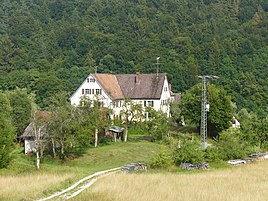Dörnhof (Graefenberg)
|
Dörnhof
City of Graefenberg
Coordinates: 49 ° 40 ′ 54 ″ N , 11 ° 16 ′ 41 ″ E
|
|
|---|---|
| Height : | 405 (398-407) m above sea level NHN |
| Residents : | 3 (Jan. 2019) |
| Postal code : | 91322 |
| Area code : | 09197 |
|
The Graefenberg district of Dörnhof
|
|
Dörnhof is a Franconian wasteland that belongs to Graefenberg .
geography
The wasteland in the southwest of the Wiesentalb is one of 15 officially named districts of the town of Graefenberg in Upper Franconia . It is located about five kilometers north-northeast of the center of Graefenberg and is at an altitude of 405 m above sea level. NHN .
history
Dörnhof had belonged to the land area of the imperial city of Nuremberg since the beginning of the 16th century , after the city had succeeded in taking possession of the surrounding area through its participation in the Landshut War of Succession . The high jurisdiction over the place had since the Nürnbergische Pflegamt Hiltpoltstein in his capacity as Fraischamt held. The advocacy over the existing location of only one property, however, was from the rich urban municipal directly exercised so that the remote area so that unambiguously nürnbergischer sovereignty under stood. In the following three centuries these conditions remained largely unchanged until the imperial city of Nuremberg was finally annexed to the Kingdom of Bavaria in 1806, in breach of the imperial constitution . With this violent takeover, Dörnhof now also became part of the New Bavarian territories that were occupied during the Napoleonic land consolidation , which was only subsequently legalized in July 1806 with the Rhenish Federal Act .
By the early 19th century in the Kingdom of Bavaria carried out administrative reforms Dörnhof was the second municipality edict in 1818 for part of the independent rural community Thuisbrunn , which also includes the four villages Haidhof , Höfles , Hohenschwärz and Neusles and the former wasteland Haselstauden heard had . In the course of the municipal territorial reform carried out in Bavaria in the 1970s , Dörnhof and almost the entire municipality of Thuisbrunn were incorporated into the town of Graefenberg on May 1, 1978, only Haselstauden was re-municipalityed to Obertrubach. At the beginning of 2019 the wasteland had three residents.
traffic
The connection to the public road network is only made by a non-asphalted field path that comes from the valley floor of the Trubach from Haselstauden, through the valley of the Großenoher Bach, past the Spiesmühle and up to Großenohe . Another dirt road branches off this unpaved path at a height of almost 400 meters, which leads to the wilderness about 200 meters to the west. The closest train station in terms of traffic is in Pretzfeld .
Attractions
As the site of a former medieval castle stable, the Dörnhof area is now a listed building.
literature
- Ingomar Bog: Forchheim . In: Historical Atlas of Bavaria . Commission for Bavarian State History, Munich 1955.
- Gertrud Diepolder : Bavarian History Atlas . Ed .: Max Spindler . Bayerischer Schulbuch Verlag, Munich 1969, ISBN 3-7627-0723-5 .
- Federal Statistical Office (Hrsg.): Historical municipality register for the Federal Republic of Germany. Name, border and key number changes in municipalities, counties and administrative districts from May 27, 1970 to December 31, 1982 . W. Kohlhammer, Stuttgart / Mainz 1983, ISBN 3-17-003263-1 .
Web links
- Bavarian authorities guide for Dörnhof , accessed on September 11, 2019
- Dörnhof in the BayernAtlas , accessed on September 11, 2019
- Dörnhof on a historical map , accessed on September 11, 2019
Individual evidence
- ↑ a b Population of Dörnhof on the Graefenberg website , accessed on September 11, 2019 2019
- ^ Dörnhof in the local database of the Bavarian State Library Online . Bavarian State Library, accessed on September 11, 2019.
- ↑ Geographical location of Dörnhof in the BayernAtlas , accessed on September 11, 2019
- ^ Eckhardt Pfeiffer (Ed.): Nürnberger Land . 3. Edition. Karl Pfeiffer's Buchdruckerei und Verlag, Hersbruck 1993, ISBN 3-9800386-5-3 , p. 100-101 .
- ↑ Gertrud Diepolder : Bavarian History Atlas . Ed .: Max Spindler . Bayerischer Schulbuch Verlag, Munich 1969, ISBN 3-7627-0723-5 , p. 31 .
- ↑ Gertrud Diepolder : Bavarian History Atlas . Ed .: Max Spindler . Bayerischer Schulbuch Verlag, Munich 1969, ISBN 3-7627-0723-5 , p. 97-103 .
- ^ Ingomar Bog: Forchheim . In: Historical Atlas of Bavaria . S. 48 .
- ^ Eckhardt Pfeiffer (Ed.): Nürnberger Land . 3. Edition. Karl Pfeiffer's Buchdruckerei und Verlag, Hersbruck 1993, ISBN 3-9800386-5-3 , p. 118 .
- ^ Sigmund Benker, Andreas Kraus (ed.): History of Franconia up to the end of the 18th century . 3. Edition. Beck, Munich 1997, ISBN 3-406-39451-5 , p. 528 .
- ↑ Gertrud Diepolder : Bavarian History Atlas . Ed .: Max Spindler . Bayerischer Schulbuch Verlag, Munich 1969, ISBN 3-7627-0723-5 , p. 35 .
- ↑ Gertrud Diepolder : Bavarian History Atlas . Ed .: Max Spindler . Bayerischer Schulbuch Verlag, Munich 1969, ISBN 3-7627-0723-5 , p. 106-107 .
- ^ Ingomar Bog: Forchheim . In: Historical Atlas of Bavaria . S. 125 .
- ^ History of Dörnhof on the Graefenberg website , accessed on September 11, 2019
- ^ Federal Statistical Office (ed.): Historical municipality directory for the Federal Republic of Germany. Name, border and key number changes in municipalities, counties and administrative districts from May 27, 1970 to December 31, 1982 . W. Kohlhammer, Stuttgart / Mainz 1983, ISBN 3-17-003263-1 , p. 684 .


